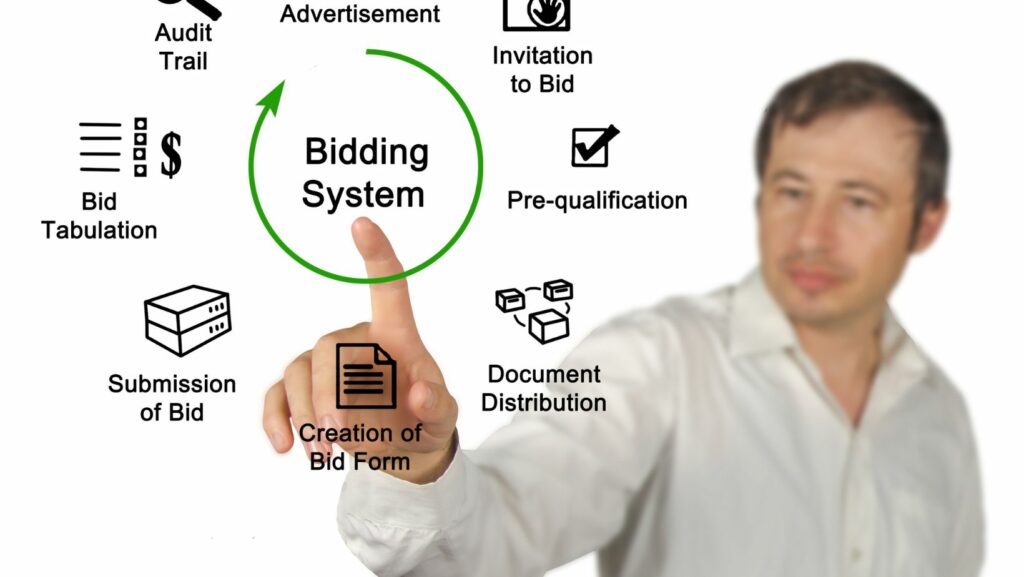In the dynamic world of digital advertising, staying ahead of the competition often hinges on the efficiency and effectiveness of one’s bidding strategy. Automated bidding stands out as a transformative solution, offering advertisers a way to optimize their ad spend with minimal manual intervention. This technology leverages machine learning to analyze vast amounts of data, enabling it to make smart, real-time bidding decisions that can significantly enhance campaign performance.
What Can Automated Bidding Help an Advertiser Improve?
 Automated bidding harnesses machine learning to optimize ad performance, ensuring advertisers get the most efficient use of their budget. It supports scalability and achieves better campaign outcomes by adjusting bids in real time.
Automated bidding harnesses machine learning to optimize ad performance, ensuring advertisers get the most efficient use of their budget. It supports scalability and achieves better campaign outcomes by adjusting bids in real time.
Automated bidding refers to a strategy where an algorithm automatically sets the bid amount for each ad impression, based on predefined targets and real-time data. This approach eliminates the need for manual bid adjustments, which can be time-consuming and less efficient. By implementing automated bidding, advertisers leverage technology to make informed, precise bidding decisions that align with their marketing goals.
How Does Automated Bidding Work?
The process of automated bidding begins with the advertiser setting specific objectives, such as maximizing clicks, increasing conversions, or achieving a target return on ad spend (ROAS). The automated system then analyzes historical data and ongoing campaign performance to determine the optimal bids for each ad placement. Factors considered include the type of audience, the context of the ad display, the time of day, and other relevant metrics that influence ad performance.
Key Benefits of Automated Bidding
Increased Efficiency in Ad Management
 Automated bidding systems streamline the management of ad campaigns, significantly reducing the labor and time traditionally required for manual bid adjustments. These systems analyze vast amounts of data to make precise bid adjustments in real-time, ensuring that ad placements are optimized continuously throughout the day. They also facilitate a quicker response to market changes, allowing campaigns to remain competitive without constant human intervention.
Automated bidding systems streamline the management of ad campaigns, significantly reducing the labor and time traditionally required for manual bid adjustments. These systems analyze vast amounts of data to make precise bid adjustments in real-time, ensuring that ad placements are optimized continuously throughout the day. They also facilitate a quicker response to market changes, allowing campaigns to remain competitive without constant human intervention.
Enhanced Targeting and Optimization
Automated bidding leverages advanced algorithms to improve the accuracy of ad targeting. By utilizing real-time data and learning from historical performance, these systems can pinpoint the most effective ad placements, optimizing the visibility and engagement of campaigns. They ensure that ads reach the most relevant audience segments, thereby increasing conversion rates and maximizing the impact of advertising budgets.
Budget Allocation and Cost Savings
One of the standout benefits of automated bidding is its ability to optimize budget expenditure. By automatically adjusting bids based on the campaign’s performance data and predefined objectives, automated bidding ensures that funds are allocated where they yield the best returns.
Examples of Effective Automated Bidding
Automated bidding systems harness advanced machine learning technology to manage digital advertising campaigns more effectively. Here are specific examples demonstrating the effectiveness of automated bidding in different scenarios:
 Adjusting Bids According to Market Fluctuations: Automated systems adjust bids in real time, reacting instantaneously to market conditions. If the competition for certain keywords increases unexpectedly, the system increases bids to ensure ad visibility, maintaining competitive advantage and exposure.
Adjusting Bids According to Market Fluctuations: Automated systems adjust bids in real time, reacting instantaneously to market conditions. If the competition for certain keywords increases unexpectedly, the system increases bids to ensure ad visibility, maintaining competitive advantage and exposure.- Optimizing for Different Time Zones: For global campaigns, automated bidding proves crucial by adjusting bids to align with the active hours of various international markets. This adaptation maximizes ad visibility when users are most likely to be online, thereby optimizing potential engagement.
- Maximizing Event-driven Opportunities: During special events or sales like Black Friday, automated bidding systems can dynamically increase bids to capture high intent customers. Engaging customers precisely when they’re more likely to make purchase decisions translates to higher conversion rates.
- Precision Targeting Based on User Behavior: Automated systems analyze past user behavior and modify bids to target users who are more likely to convert. For example, someone who has visited a site multiple times might see more competitive bids for ads related to products they’ve viewed, enhancing the likelihood of a purchase.
- Cost-Efficient Use of Advertising Budgets: By setting maximum bid limits and allowing the system to dynamically adjust within these parameters, advertisers ensure they do not overspend on ads. Automated bidding strategically allocates budget to high-performing ads, thus reducing wasted expenditures on underperforming segments.



